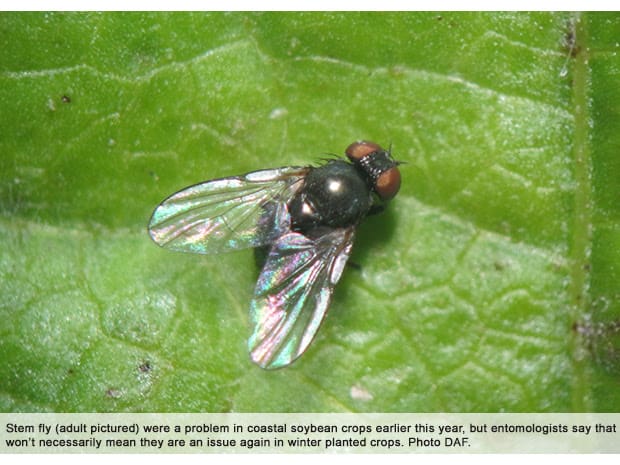AFTER a summer fraught with disease and pest issues, soybean growers in Queensland’s coastal regions are urged to use best practice planning to minimise their risks ahead of winter crop planting.
Earlier this year, growers in the Burdekin region had to contend with an outbreak of two soybean diseases – Target Spot and Anthracnose – as well as the pest, stem fly (Melanagromyza sojae).

QDAF plant pathologist, Lisa Kelly. (Photo: GRDC)
Queensland Department of Agriculture and Fisheries (DAF) plant pathologist Lisa Kelly said the combined disease and (to a lesser extent) pest pressure had had a marked impact on summer soybean crop yields and it was imperative growers did what they could now to minimise risks ahead of winter planting.
Ms Kelly said there were key decisions growers could make in advance to reduce the potential impact of diseases, such as Target Spot and Anthracnose.
“These diseases were present in soybean crops in both the Burdekin and Bundaberg regions earlier this year and caused significant crop losses,” she said.
“There are currently no fungicides registered in soybeans to manage Target Spot, so growers have to rely on best practice agronomic planning to reduce their risk.
“It is a similar situation for anthracnose, although the GRDC supported industry following the outbreak this year and obtained an emergency permit It (PER89395) for the use of Veritas® fungicide in soybean against Anthracnose.”
Preventative planning
Target Spot causes reddish-brown lesions in the leaves in the lower canopy, which then spreads up the plant. With extended rainfall, high humidity and warm temperatures the disease can cause leaf defoliation and plant death. The disease is soil borne and can be spread in the wind, rain and on infected seed.
Anthracnose also occurs after prolonged periods of high humidity and symptoms include necrosis of leaf laminar veins, leaf rolling, petiole cankering and premature defoliation. In advanced stages the plant can be covered with black fungal fruiting bodies with minute black spines.
“With forecasts of a wetter than average winter and often warm temperatures in coastal regions it is advisable that growers take preventative planning action to reduce the risk as they plan winter soybean planting,” Ms Kelly said.
“It is important they keep front of mind that these disease pathogens will survive between crops in the soil, on infected crop debris and on seed, so pre-planning is their best tool.”
Growers in the Burdekin and Bundaberg regions considering planting soybeans this winter are encouraged to consider the following:
- Avoid planting soybeans in or close to previously affected paddocks for at least two years
- Avoid successive plantings as this can build up of both diseases and pests
- Avoid sowing seed from affected crops
- Consider burial of crop residues
- Rotate affected areas with non-disease hosts, for example maize, grain sorghum, or sugarcane to reduce disease inoculum
- Control weeds and volunteer soybean plants that may host diseases
- Consider agronomic factors that may reduce humidity, such as planting at a lower seed rate or wider rows to encourage air flow
- Avoid excess or overhead irrigation.
Spasmodic outbreaks
Meanwhile, experienced entomologist Hugh Brier advised growers that stem fly outbreaks tended to be spasmodic and high numbers in February and March would not necessarily translate to problems in July.
“The confounding issue for growers is that while stem fly can be potentially controlled with repeated sprays of dimethoate, this approach unfortunately kills many beneficial insects and is likely to flare, mites, whitefly and helicoverpa,” Mr Brier said.
“This approach was shown to be ineffective against high stem fly populations in a major outbreak in 2013 in the Casino region of NSW.
“Interestingly plants in the 2013 Casino outbreak were also severely infected with another disease, charcoal rot, and showed symptoms (sudden plant death at podfill) similar to this year’s crops in the Burdekin.”

Mr Brier said during another significant stem fly outbreak in 2018 at Casino in soybean cultivar A6785, there were no severe leaf and plant death symptoms. Interestingly, this is the same cultivar that was severely affected Burdekin summer soybeans earlier this year.
“However, given the cooler temperatures in winter, it is not anticipated that stem fly will be nearly as active in the July plantings,” he said.
“However, stem fly can potentially cause damage in younger crops so growers should keep a look out for stem fly damage symptoms and report them to their agronomists or relevant DAF staff.”

Source: GRDC
Affected crop samples can be sent to QDAF for diagnosis. Plant samples should be wrapped in paper towel and placed in labelled zip-locked bags and sent via courier or express post to Lisa Kelly, DAF, 203 Tor St, Toowoomba, 4350 or to Hugh Brier, DAF, PO Box 23, Kingaroy, 4610. Alternatively, growers or advisers can send photos of the pest or disease damage to [email protected].

HAVE YOUR SAY